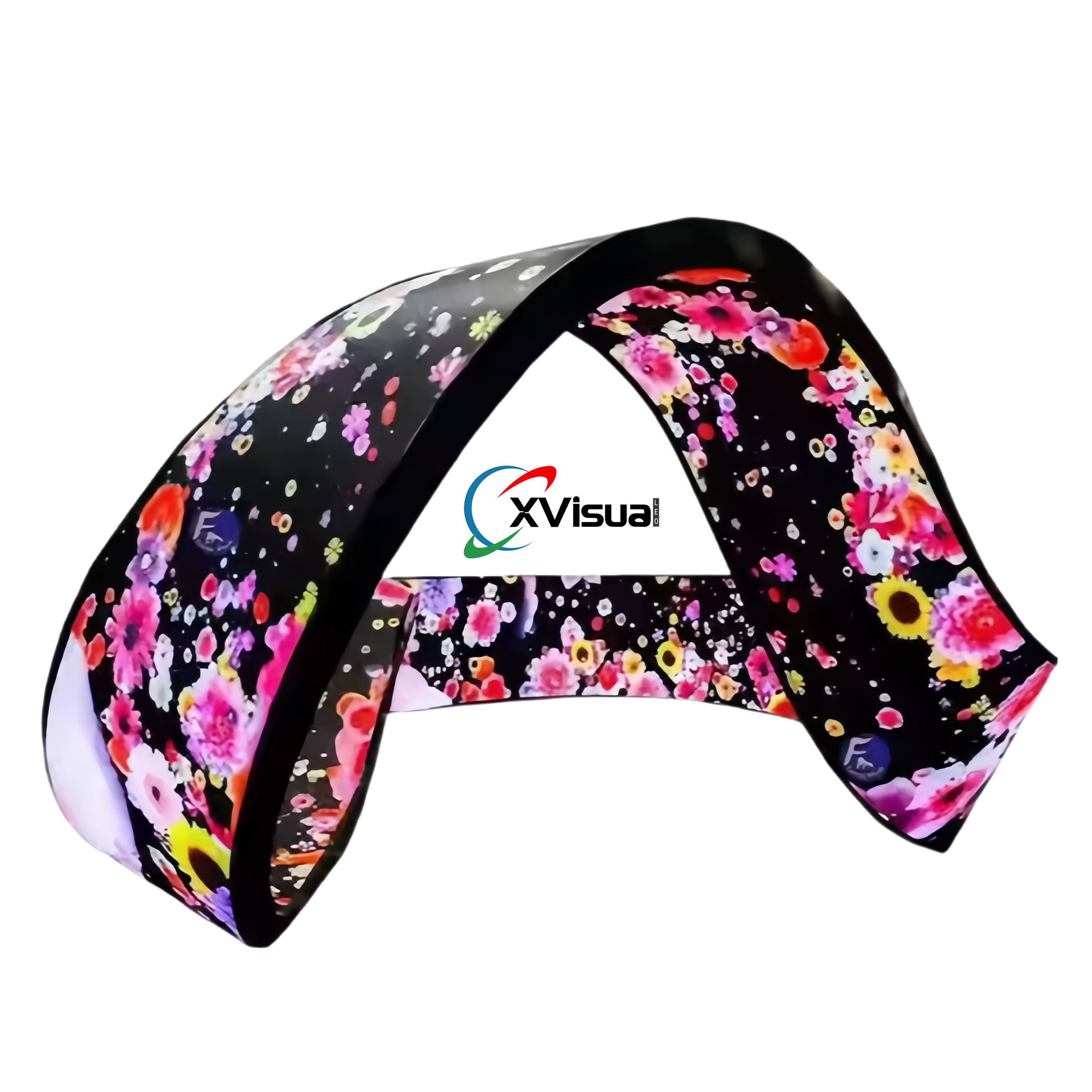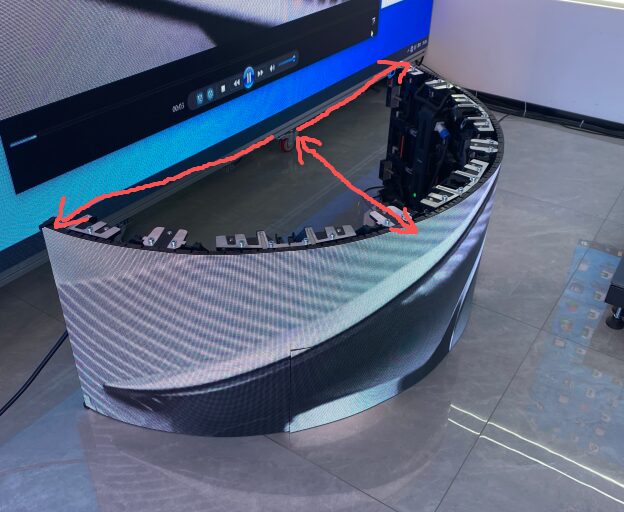En el panorama en evolución de la iluminación arquitectónica y los medios inmersivos, LED ribbon displays have become a critical medium bridging structure and storytelling. Their ability to wrap around curved surfaces, contour complex geometries, and maintain a continuous image has redefined modern digital design. Sin embargo, beneath the dazzling surface of these flexible displays lies an engineering challenge: achieving visual continuity through precise pixel pitch calibration.
The relationship between pixel pitch and curvature is a balance of optics, mechanics, and material science. A curved LED ribbon display demands both flexibility and uniform pixel alignment to ensure that no gaps, distortions, or luminance inconsistencies occur when bending the screen. Understanding this balance is essential for designers and engineers seeking to optimize both performance and aesthetic coherence.
1. Understanding Pixel Pitch and Its Optical Role
Pixel pitch refers to the distance between the centers of two adjacent pixels, typically measured in millimeters. In traditional flat LED screens, smaller pixel pitches yield sharper resolution and smoother image gradients. Sin embargo, when applied to curved LED ribbon displays, pixel pitch influences not only image quality but also mechanical flexibility and viewing consistency.
A tighter pixel pitch means denser LED placement, which enhances detail but reduces the screen’s ability to bend. Larger pixel spacing, on the other hand, increases flexibility but risks visual discontinuities, especially on tight-radius installations. Therefore, the choice of pitch is not merely a question of visual clarity; it defines the very curvature limits of the display’s structure.
Moreover, optical uniformity across a curved surface depends on how evenly pixels emit light when viewed at varying angles. Engineers must ensure that the pitch supports consistent brightness distribution, minimizing moiré effects and pixel stretching that can occur along the inner and outer curves.
 2. The Mechanical Constraints of Curvature Design
2. The Mechanical Constraints of Curvature Design
Designing a curvo LED ribbon display involves more than adjusting physical flexibility. Every LED module undergoes mechanical stress when bent, and pixel pitch determines how this stress distributes across the substrate. If the pitch is too narrow, bending may cause micro-fractures in the solder joints or disrupt circuit continuity.
Modern ribbon displays use segmented module architectures, where each module connects through a flexible printed circuit (FPC) that tolerates repeated bending. The bending radius directly correlates with pixel pitch density—the tighter the curvature, the more spacing is needed to accommodate safe deformation.
Furthermore, the thermal management system must adapt to this design. Closely packed LEDs generate concentrated heat, which can alter color consistency or cause premature degradation in curved configurations. Therefore, thermal diffusion materials and airflow optimization are integral to maintaining both performance and lifespan.
3. Pixel Pitch Optimization: Balancing Resolution and Flexibility
The ideal pixel pitch for a curved LED ribbon display depends on three factors: the curvature radius, the intended viewing distance, and the content type. For installations such as retail signage or immersive museum walls, where viewers stand within proximity, smaller pitches (1.9–2.5 mm) deliver crisp definition. Sin embargo, these require gentle curves to prevent pixel stress.
In contrast, for architectural façades or outdoor installations with wider viewing angles, pitches between 3.9–6.9 mm provide optimal durability and flexibility. These larger pitches allow designers to craft dramatic curves or cylindrical displays without visual fragmentation.
Balancing resolution with flexibility is not a linear process. Engineers often use computer simulation tools to model pixel alignment across varying radii, ensuring the image appears continuous from multiple perspectives. This digital mapping ensures that even as the physical geometry bends, the visual data maintains proportional integrity.
4. Integration of Flexible Substrate and Magnetic Mounting Systems
Modern LED ribbon displays achieve their curvature through advanced substrate engineering. Instead of rigid aluminum housings, manufacturers now employ silicone-based or polymeric backplates that can sustain repeated bending without fatigue.
The integration of magnetic mounting systems has further enhanced assembly precision. Each module magnetically attaches to a curved metal framework, allowing micro-adjustments during installation to align pixel grids seamlessly. This approach also simplifies maintenance, as individual panels can be replaced without disturbing the entire surface.
Additionally, the modular system supports multi-directional curvature—concave, convex, or even compound surfaces—making it suitable for architectural domes, circular stages, and cylindrical advertisements. When combined with fine-tuned pixel pitch calibration, these innovations ensure uninterrupted visual transitions across any spatial form.
 5. Power and Signal Design in High-Curvature Displays
5. Power and Signal Design in High-Curvature Displays
Electrical design plays an equally vital role in ensuring visual continuity. Curvo LED ribbon displays require uniform voltage distribution across varying lengths and angles. Irregular power flow can result in brightness inconsistencies or flickering, particularly in high-density configurations.
To address this, modern designs use segmented power rails integrated into the flexible PCB. This architecture ensures stable current delivery while maintaining the physical elasticity of the module.
Moreover, signal synchronization across curved panels demands high-precision data routing. Engineers employ differential signal transmission and daisy-chained controllers to prevent timing delays or image tearing during fast-motion content playback.
Another consideration lies in thermal dissipation. Power distribution boards often double as heat sinks, transferring thermal energy away from high-density pixel clusters. This hybrid approach reduces component fatigue while ensuring stable chromatic balance over time.
6. Optical Calibration and Color Uniformity
Even with ideal pixel spacing and curvature design, optical calibration remains essential. When a display bends, viewing angles shift across its surface, altering the perceived luminance and color balance. This phenomenon becomes more noticeable in small-pitch designs, where micro-variations in LED positioning can create visual banding.
To counter this, manufacturers use multi-angle colorimetric calibration systems. By capturing emission data at various angles, these systems adjust brightness and color coefficients to maintain uniformity. The calibration process typically involves both hardware (sensor-based scanning) and software correction (lookup table optimization).
Such fine-tuning ensures that a curved LED ribbon display performs identically whether viewed head-on or from a 45-degree angle, maintaining immersive visual coherence even in complex architectural environments.
7. Engineering Trade-offs: The Art of Compromise
The engineering of curved LED ribbon displays is a study in compromise. Smaller pixel pitches deliver exquisite detail but limit flexibility. Larger pitches enable bold curvature but may sacrifice image refinement at close range. Similarly, rigid power structures ensure consistency yet reduce bend radius.
The most successful designs find equilibrium between these opposing needs. By employing flexible substrates, adaptive mounting systems, and intelligent calibration software, engineers can push the boundaries of curvature while preserving resolution fidelity.
Every design decision—from LED encapsulation to power routing—serves one unified goal: seamless visual continuity. The harmony between physical form and digital precision is what distinguishes a well-engineered ribbon display from a mere flexible screen.
Conclusión: Continuity as the Measure of Innovation
In the engineering of curved LED ribbon displays, pixel pitch is far more than a specification—it is the invisible thread weaving structure and perception together. It determines how images flow across curvature, how light interacts with form, and how technology harmonizes with architecture.
Achieving visual continuity in flexible LED displays demands a delicate synthesis of mechanical precision, optical calibration, and electronic control. As the industry advances, the mastery of pixel pitch design will remain the cornerstone of innovation, guiding how designers translate imagination into luminous reality.



 2.
2.  5.
5. 